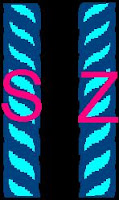TEXURISATION
Texturisation is the process by which flat filaments are distorted to have crimps, coils, curls or loops along their length to achieve bulk and greater absorbency.
Basic principal of texturisation:
Texturisation is performed in three steps:
To heat the yarn plastic condition.
To impart the required shape of filament.
To cool it to retain the shape.
Advantage:
Crease resistance.
Better appearance.
Higher absorbency and better perspiration conductivity.
Better air permeability.
More flexible.
Disadvantage:
Decrease abrasion resistance.
Creates hairiness of fiber.
Create problem in laundering.
Process of texturisation:
In the texturing processes, a continuous filament (cf) yarn has to undergo a major change in its physical form, by becoming crimped. Coiled or looped along its lengths.
Only multi filament cf yarns are suitable for texturing.
There are various methods that may be used to produce textured cf yarns.
Most are only applicable to thermoplastic cf yarns as they involve heating the filaments while effecting the textured profile, then cooling to retain it in the filaments.
There are different methods of texturisation process. They are,
Stuffer box
Knife edge
Air jet
Knit-de-knit
False twist
1. Knife edge:
Where the filament yarn is heated and pulled across a knife at an acute angle. When the yarn is cooled and released it retains a spring or curled ribbon appearance, i.e. the profile is heat-set.
Here the filaments pass through a heated box, but are fed into it faster than their removal rate – i.e. an overfeed. This force them to adopt a random wavy crimped pattern while heated; subsequent cooling sets their textured form.
With this method overfeeding of filaments at high speed into a chamber is also employed, but instead of using heat to facilitate the texture profile, compressed air is blown into the chamber and this causes the loose lengths of the filaments in the yarn to spread apart and form entangled random loops. The entanglement retains the texture of random loops.
4. False twist:
In this method the cf yarns are twisted and heated simultaneously, and then untwisted when cold, thereby loosely retaining the heat-set helical shape of the twist.
5. Knit-de-knit:
Here filament yarns are knitted into a narrow diameter tube and heat-set (i.e. heated and then cooled). The yarns are then de-knitted, giving them a wavy configuration.
PROPERTIES OF YARN
Fabric quality means different characteristics of finished fabric which is totally depends on yarn characteristics and fabric construction. The quality of hosiery yarn has to be considered with due weight-age fluidity of knitted structure and their influence on knit fabrics quality.
The crucial yarn properties to be considered would be twist in yarn for shortest possible gauge length, within variation of friction in yarn, yarn irregularity, torsional rigidity and flexural rigidity.
Mechanical properties of yarn
Some important mechanical properties of yarn are-
Frictional properties,
Flexural properties,
Tensile properties,
Torsional properties.
Tensile properties of yarn
Important tensile properties of yarn are -
Elasticity,
Breaking extension,
Plasticity,
Elastic limit,
Breaking point,
Elongation.
Properties of yarn for knit fabric manufacturing
The below characteristics of yarn has needed during knit fabric manufacturing or knitting.
Yarn count,
Co-efficient of variation (cv%),
Twist in yarn,
Twist variation in yarn,
Regularity or evenness of the yarn,
Imperfection in the yarn,
Thick place in the yarn,
Neps,
Thin place in yarn,
10. Hairiness,
11. Yarn strength,
12. Strength variation in yarn.
Effect of Fiber length on yarn properties
Those are-
Yarn strength,
Processing efficiency,
Yarn handle,
Yarn count,
Yarn hairiness,
Luster,
Yarn evenness,
Production.
Effect of Fiber fineness on yarn properties:
Those ares-
Yarn count,
Yarn strength,
Flexibility,
Luster,
Spinning limit,
Torsional property.
Effect of Fibre strength on yarn properties:
Those are,
Fiber damage,
Yarn strength,
Spinning performance.








Comments
Post a Comment